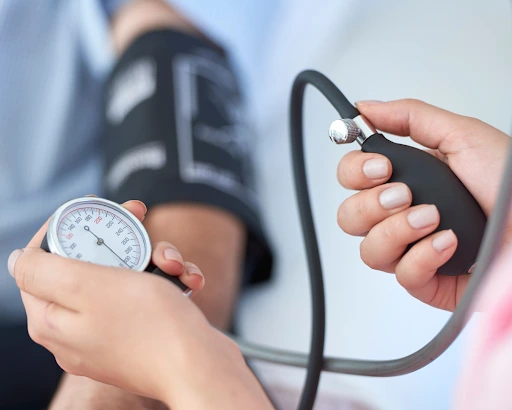Book Appointment Now

What Every Seafarer Needs to Know About Hypertension
- On
- InMarine
Life at sea comes with its own rhythm—a mix of discipline, routine, and unpredictability. While many seafarers are used to handling pressure on deck, there’s a silent kind of pressure that deserves equal attention: hypertension, or high blood pressure.
Hypertension is one of the most common health conditions affecting adults today—and it often goes unnoticed until it becomes serious. For seafarers who spend months at sea, the risk is even greater due to long hours, high stress, and limited access to regular healthcare. In this post, we’ll walk through the basics of hypertension, why seafarers are especially at risk, and how to manage it both on land and onboard.
What is Hypertension?
Hypertension occurs when the pressure of blood pushing against the artery walls remains consistently high. It can lead to serious complications like heart disease, stroke, kidney problems, and vision loss if not managed properly.
Blood Pressure Ranges:
- Normal: Below 120/80 mmHg
- Elevated: 120–129/<80 mmHg
- Stage 1 Hypertension: 130–139/80–89 mmHg
- Stage 2 Hypertension: 140+/90+ mmHg
Many people with hypertension feel completely fine, which is why it’s often called the “silent killer.”
Why Seafarers are More Vulnerable
Several unique factors contribute to the increased risk of hypertension among seafarers:
1. Occupational Stress
The shipping industry is demanding. Long working hours, operational responsibilities, and periods of isolation from family and friends all contribute to chronic stress—one of the key triggers for high blood pressure.
2. Limited Physical Activity
While some roles onboard involve physical labor, others are largely sedentary. Over time, a lack of regular movement can lead to weight gain and increased blood pressure.
3. High-Sodium Diet
Shipboard meals often rely on canned or preserved foods due to storage limitations. These foods tend to be high in sodium, which can elevate blood pressure.
4. Sleep Disruptions
Rotating shifts and irregular schedules affect circadian rhythms and reduce sleep quality—both of which impact cardiovascular health.
5. Substance Use
To cope with isolation or boredom, some seafarers may resort to smoking or drinking—both of which can accelerate the onset or severity of hypertension.
The Role of the Seafarers Medical Fitness Examination
Before signing on to a vessel, all crew members are required to undergo a pre-employment medical examination (PEME). This screening ensures that a seafarer is physically fit to work onboard. One of the key elements checked during this exam is blood pressure.
While passing the fitness exam is a good sign, it’s important to remember that blood pressure can fluctuate and change over time. A clean bill of health today doesn’t guarantee that issues won’t develop later—especially if there’s no follow-up or consistent health monitoring while onboard.
That’s why choosing a trusted maritime medical clinic is important. A good clinic doesn’t just check the box during pre-employment exams—they also provide education and advice on diagnosed medical conditions and the long-term health risks, including hypertension.
How to Spot the Signs
Hypertension often has no noticeable symptoms, but some people may experience:
- Headaches
- Blurred vision
- Chest discomfort
- Fatigue or confusion
- Irregular heartbeat
If you experience any of these symptoms, don’t ignore them. Report them to your medical officer onboard and seek advice from a medical professional as soon as possible.
Tips for Managing Hypertension at Sea
Even if you’re far from a hospital or clinic, there are ways to manage and prevent high blood pressure while onboard:
1. Take Medications as Prescribed
If you’ve been diagnosed with hypertension and prescribed medication, consistency is key. Always carry enough medication to last through your entire contract. The Halcyon Health App offers a medication tracker feature that reminds you to take your medicine and keeps a simple log—helping you stay on track no matter your shift schedule.
2. Monitor Your Blood Pressure
Bring a digital blood pressure monitor onboard if possible. Regular self-checks help you spot patterns or spikes early and report them during your next PEME.
3. Eat Smart
Choose steamed or grilled options over fried, and avoid adding condiments like soy sauce or fish sauce to your food. Reduce intake of processed meats, instant noodles, and salty snacks.
4. Stay Active
Use whatever space and time you have. Even 15 minutes of brisk walking on deck, cabin workouts, or bodyweight exercises can help keep blood pressure in check.
5. Limit Alcohol and Tobacco
Both can raise your blood pressure and reduce the effectiveness of medications. Cutting down or quitting altogether can significantly improve your health.
6. Manage Stress
Take a few quiet minutes each day to unwind, breathe deeply, and reflect.
Know When to Seek Help
If you experience chest pain, numbness, shortness of breath, or trouble speaking—seek help immediately. These could be signs of a heart attack or stroke. Always inform your ship’s medical officer and have these symptoms documented for future consultations.
A Word from SSMA

Since 2012, SSMA has been at the forefront of post-medical case management for seafarers. We understand the challenges that come after a PEME, the medical concerns that may arise onboard, and the need for proper follow-up upon returning to land. That’s why we provide reliable support to ensure seafarers get the care they need, including:
- Post-medical case handling
- Telemedicine and guidance on continuity of care
Conditions like hypertension are common findings during PEMEs, but they don’t have to end a career at sea. With proper case management, timely medical interventions, and coordinated follow-up, seafarers can continue their work while staying on top of their health.
At SSMA, we make sure no case is left unattended. From the first report to recovery and clearance, we guide seafarers and manning agencies every step of the way. Our role is to bridge the gap between diagnosis and recovery—because seafarers deserve continuous care and safe return to duty.
